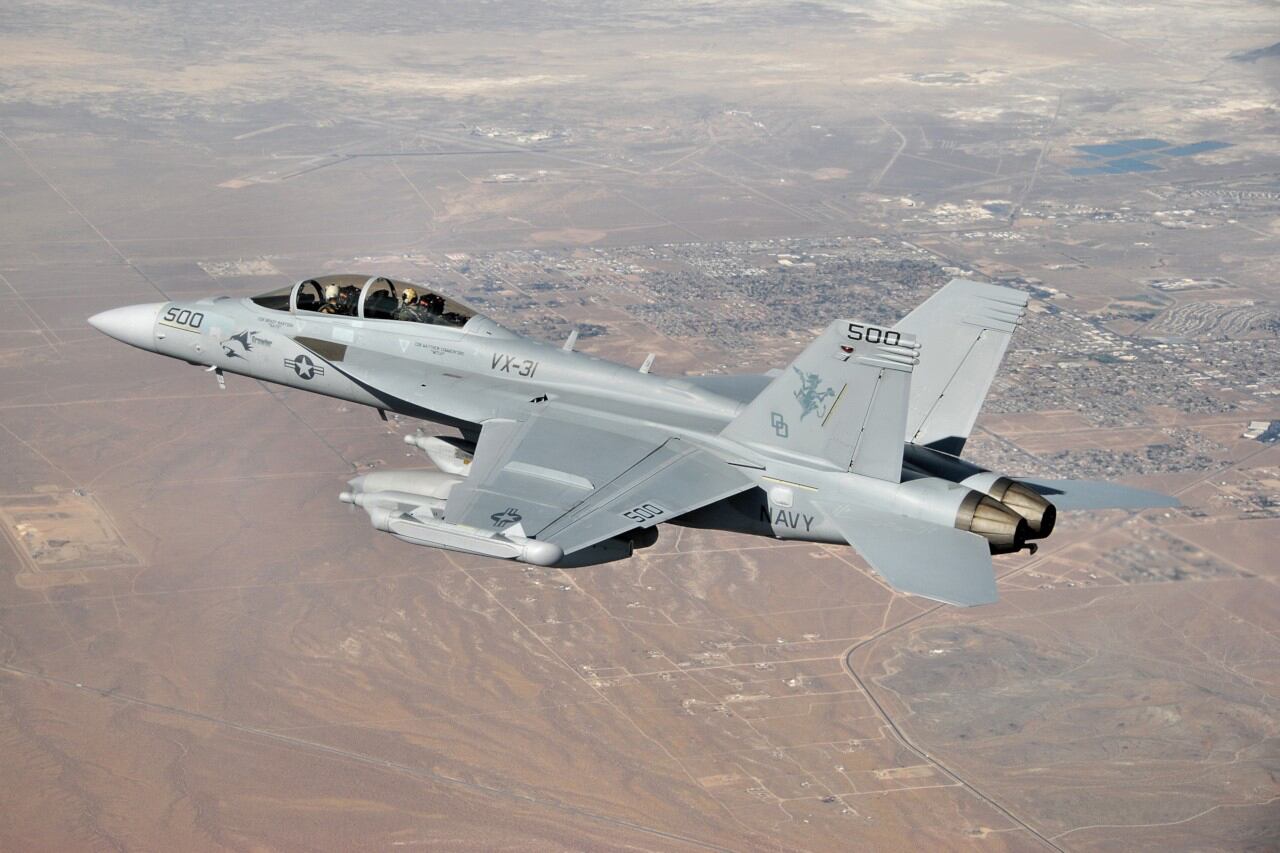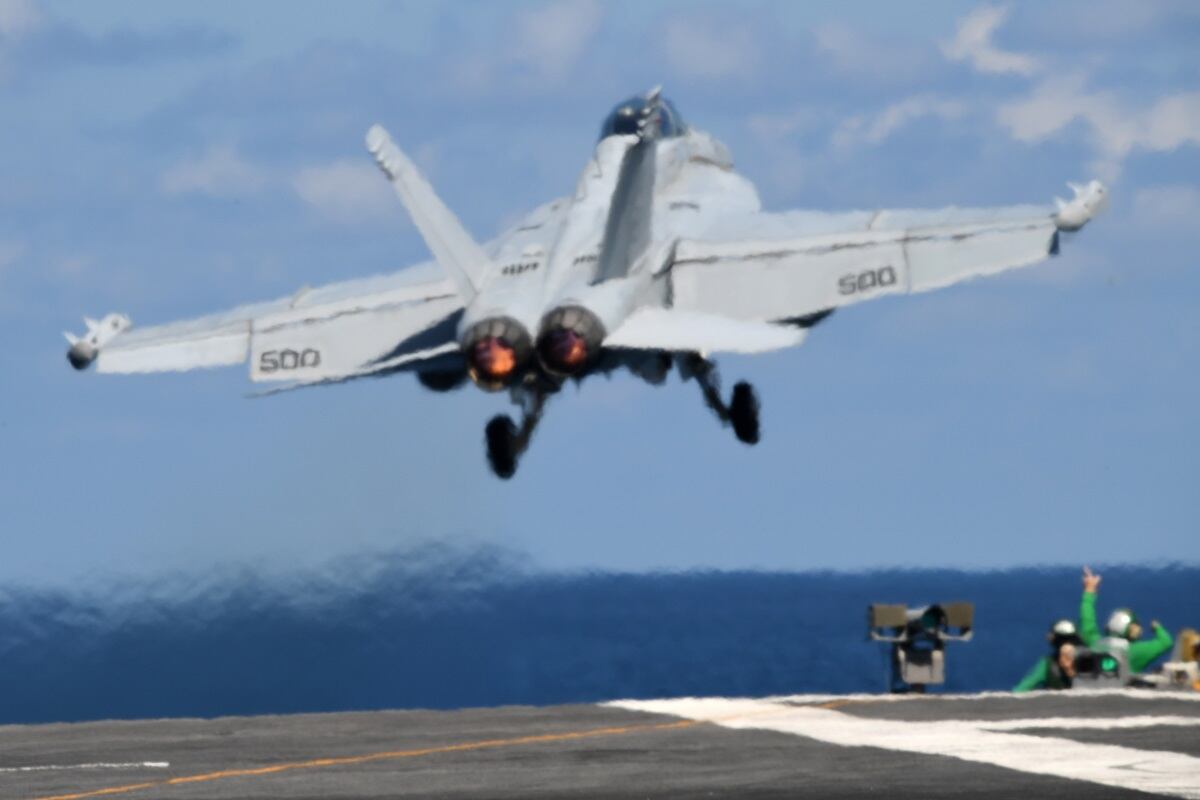The Navy has awarded $27 million in contract extensions to two companies working to demonstrate a proof of concept for the service’s next phase of its premier airborne electronic warfare system.
Northrop Grumman and L3 were awarded $13.5 million and $13.6 million, respectively, to continue working on the Next Generation Jammer Low Band program, according to a May 8 Department of Defense announcement. The funds will expand the analysis and design of the Navy’s Next Generation Jammer low band pod.
The Next Generation Jammer is the Navy’s plan to update the legacy jamming pods aboard EA-18 Growlers, serving as the joint force’s premier stand off electronic attack platform. The Navy is breaking the program into three pods: mid band, which was awarded to Raytheon in 2016, low band and high band.
RELATED

Adversaries can both hide and attack certain systems within the entirety of the electromagnetic spectrum and to combat that threat the military needs systems that can operate the across that spectrum. National security experts have said the spectrum is too expansive for a single pod to handle, which results in high, mid and low pods.
Navy budget documents released in March call for $6.2 million in fiscal year 2020 for mid band from the procurement budget with $524.2 million coming from the research and development budget. Additionally, over the next five years, the Navy plans to spend $4.8 billion for procurement and $3.9 billion in R&D for mid band projects.
Northrop — whose team consists of Harris, Comtech PST — and L3 were selected to separately demonstrate solutions for the low band to help the Navy refine requirements for the final program and reduce risk. Each were awarded a 20-month contract in October 2018.
RELATED

Funding for the high band program does not appear in the Navy’s fiscal 2020 budget documents.
“Northrop Grumman is pleased to have been selected by the U.S. Navy in October 2018 for the Next Generation Jammer Low Band Demonstration of Existing Technologies (DET) program. The additional funding awarded on May 8, will allow the Northrop Grumman-led industry team to continue to work closely with the Navy to continue to reduce risk and support requirements for this fast-paced program,” Curtis Pearson, director of Advanced Programs at Northrop Grumman, said.
An L3 spokesperson told C4ISRNET in a statement: “With this week’s development funding, L3 Technologies will be able to accelerate delivery of new and much needed capabilities to the fleet through the U.S. Navy’s Next Generation Jammer Low Band program. As the spectrum converges between Communications and Electronic Warfare, we saw that we could addresses current, advanced, and emerging threats with an innovative approach. We have a mature, low-risk, affordable solution, and we are confident in our ability to perform for our Navy customer.”
The Navy issued a request for information to industry for low band to refine the program’s requirements May 15.
What’s next for low band?
According to budget documents, the Navy requested $111 million for low band research and development funds in fiscal 2020 and a total of $3.4 billion over the next five years.
Today, the military has identified potential targets that exist within certain portions of the electromagnetic spectrum. But as adversaries become more sophisticated, the military has to adjust its approach for exploiting these vulnerabilities.
“We’ve all been writing and reading about how traditional radar targets, communication targets, network targets, they’re all collapsing into one,” John Thompson, director of business development for airborne C4ISR at Northrop Grumman, told C4ISRNET in a February interview. “As we move into this networked world, that becomes more and more ways for enemy forces to attack, opposing forces to attack each other and to defend these same areas or vulnerabilities back and forth.”
Thompson said Northrop Grumman hopes to help the military find new ways to attack these targets.
The low end of the spectrum, which the low band jammer addresses, is of interest because of the intersection of networks, communication devices and radars within it, he said. These systems have more capability against stealth-shaped airframes, Thompson said.
As a standoff jammer, the Growler’s role is to attack radars and other systems that can detect or thwart friendly aircraft and systems, allowing them to penetrate enemy airspace.
While the Growler has the reputation of being a “loud” jammer, meaning it used brute force rather than a more stealthy approach, which can alert enemies to its presence, Thompson noted that in the future there will be more nuanced approaches to jamming rather than just shoving raw jamming power toward a radar.
In finding new ways of jamming, Thompson said, maybe the individual networks and communication devices that make it up can be isolated and jammed creating confusion.
Joint airborne electronic attack
According to Navy budget documents, the Navy has been tasked with the airborne electronic attack mission in various theaters over the last few decades. While the Pentagon relied on the Growler, it also used the EA-6B Prowlers, operated by both the Navy and Marine Corps. The Prowlers have now been officially retired.
The Next Gen Jammer will “provide the ability to effectively engage enemy threats from increased stand-off distances, employ increased capacity (number of jamming assignments) against enemy targets, and support agile employment by operators,” according to the documents.
Moreover, the Air Force, following the divestment of many of its electronic attack aircraft following the Cold War, does not have a comparable asset. Air Force pilots often integrate with Navy pilots flying Growlers.
A May 2019 Congressional Research Service report notes that DoD has three primary manned electronic attack aircraft. These include the Navy’s Growler, the Air Force’s EC-130H Compass Call and the Air Force’s EC-37B Compass Call Re-Host. The report does note, however that the F-35 has “extensive, integrated EW capabilities.”
The Compass Call disrupts enemy communications as well as command and control systems.
Air Force leaders have acknowledged that the service has taken its eye off the high-end fight involving electronic warfare. During the counterterrorism fight of recent years, the Compass Call was used to jam terrorists’ communications. According to Air Force budget documents, the Compass Call overhaul will allow the Air Force to “effectively conduct Electronic Attack (EA) in an Anti-Access/Area Denial (A2AD) environment,” which applies to more complex operating environments against near-peer adversaries.
The Air Force recently finished a year-long study to identify ways the service can improve electronic warfare capabilities and posture.
One item in the Air Force’s research and development budget for airborne electronic attack seeks to address and resolve gaps across the EW enterprise. Specifically, in fiscal 2020, two items look to support and field systems identified from the year-long study. The entire effort, however, is only asking for $2,000.
Meanwhile, the Congressional Research Service noted two areas that Congress should look for in terms of oversight of the airborne electronic attack enterprise across the joint force.
One is whether DoD is properly prioritizing airborne electronic warfare programs in its planning and budgeting relative to other U.S. military EW programs for ground forces and surface ships. The report points to hardened enemy airspace fortified by so-called anti-access/area denial capabilities that use radars and long range missiles to keep forces far away preventing them from penetrating.
Second, the report notes that Congress may want to look into the Pentagon’s proposed mix of airborne EW capabilities and investments.
Mark Pomerleau is a reporter for C4ISRNET, covering information warfare and cyberspace.








